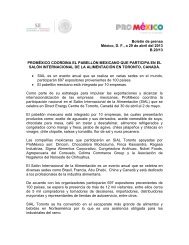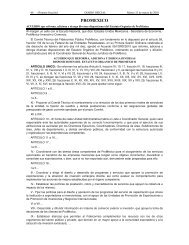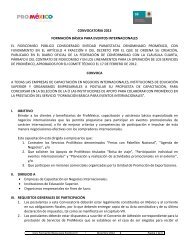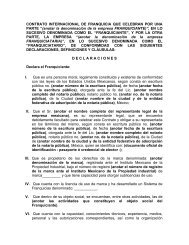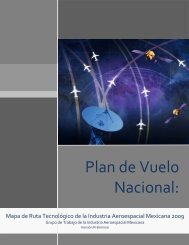mexico renews itself - ProMéxico
mexico renews itself - ProMéxico
mexico renews itself - ProMéxico
Create successful ePaper yourself
Turn your PDF publications into a flip-book with our unique Google optimized e-Paper software.
34 Negocios ProMéxico Negocios ProMéxico 35<br />
Soaking Up<br />
the Advantages<br />
of a Sunny Country<br />
One more point must be added in Mexico’s favor: the intense and continuous solar radiation<br />
that the territory receives all year long. The sun is what will drive the new electrical energy<br />
generation strategies toward a future with lower fossil fuel consumption.<br />
____<br />
by omar magaña<br />
photos courtesy of energías renovables de méxico<br />
Although solar energy<br />
projects are still considered<br />
expensive, especially<br />
photovoltaic, ERDM<br />
has demonstrated their<br />
feasibility in communities<br />
where it is technically<br />
difficult –if not impossible–<br />
to bring in the CFE network.<br />
A<br />
YouTube video posted by solar panel manufacturer<br />
Energías Renovables de México (ERDM) presents a<br />
peerless narrative of its pioneering work in promoting<br />
photovoltaic energy in Mexico.<br />
The camera documents the process of delivering dozens of<br />
photovoltaic modules that were assembled by ERDM in its plant in<br />
San Andrés Tuxtla, Veracruz, to the fishing community of Martín<br />
Prieto, in the Veracruz municipality of Alvarado.<br />
Delivering island system panels, which have their own energy<br />
converter and battery that provide users with direct electricity<br />
without needing a connection to the Federal Electricity Commission<br />
(CFE) network, seems difficult: fishermen and technicians<br />
transport modules and solar refrigerators on fishing boats that<br />
navigate the waters of the Papaloapan River to complete the delivery<br />
and begin the installation of the technology that will radically<br />
change the lives of Martín Prieto’s inhabitants: the residents will<br />
have electricity in their homes.<br />
“ERDM grew out of the necessity of certain areas of the country<br />
where it is difficult to access electric power. The company has specialized<br />
in island systems that use battery backup for communities<br />
that do not have access to the national electricity network,” says<br />
Vladimir Ruiz, an engineer who is the company’s Project Manager.<br />
Although solar energy projects are still considered expensive,<br />
especially photovoltaic, ERDM has demonstrated their feasibility<br />
in communities where it is technically difficult –if not impossible–<br />
to bring in the CFE network.<br />
The investment in photovoltaic modules in Martín Prieto came<br />
to 2 million pesos (around 150,000 usd), compared to the over 30<br />
million pesos (close to 2.25 million usd) it would have cost to make<br />
the CFE connection, according to calculations by Vladimir Ruiz.<br />
A Sun-Soaked Country<br />
The tourists that arrive in Mexico from around the world are not<br />
mistaken: the country is enviably sunny almost all year-round.<br />
According to figures furnished by the Special Program for<br />
the Exploitation of Renewable Energies published by the Ministry<br />
of Energy (SENER), Mexico has an average annual radiation<br />
of 5 kilowatts/hour (kWh) per square meter –with an index<br />
of 4.4 kWh per square meter in the center of the country and 6.3<br />
in the north.<br />
Sonora, Chihuahua and the Baja California peninsula hold the<br />
highest potential for generating electricity by taking advantage<br />
of solar radiation, due to their vast size and weather conditions<br />
throughout the year.<br />
The SENER document recognizes that taking advantage of<br />
such a renewable, clean and endless energy –the sun will be<br />
around for several million years yet– has barely been explored; it<br />
estimates Mexico’s installed capacity at 18.5 MW, which produces<br />
8,794 megawatts/hour (MWh) per year.<br />
“Globally, the generation capacity of photovoltaic cells is<br />
around 6,000 MW, installed mainly in Germany, Japan and the<br />
US,” reveals the report, based on data from the International Energy<br />
Agency (IEA).<br />
Indeed, the greatest use of photovoltaic technologies in Mexico<br />
has been in rural communities like Martín Prieto, in Veracruz. According<br />
to ERDM estimates, there are approximately 7 million people<br />
who live in areas without access to the CFE network, says Ruiz.<br />
Photovoltaic Energy Takes Center Stage<br />
ERDM is trying to gain influence on another important front: the<br />
consolidation of photovoltaic projects with a CFE interconnection.<br />
The company, which was founded almost 10 years ago by two<br />
German partners, discovered new development possibilities in<br />
Mexico after the Law for the Exploitation of Renewable Energies<br />
and Financing of the Energy Transition (LAERFTE) was signed<br />
toward the end of the last decade.<br />
Since then, ERDM has sold photovoltaic technology –modules<br />
that are assembled in Mexico from components manufactured in<br />
Germany, Austria, the US and Canada– to the National Forestry<br />
Commission (CONAFOR), the Grupo México mining corporation,<br />
the National Workers’ Housing Fund Institute (INFONAVIT), the<br />
Lázaro Cardenas port terminal, the San Isidro mill, hotels, schools<br />
and social assistance housing builders.<br />
“This is only a small step. We believe that much more is needed<br />
to really boost the photovoltaic industry,” says Ruiz, who considers<br />
that with the announcement of LAERFTE, agreements and adjustments<br />
will be generated in Mexico to advance toward that goal.<br />
An important step would be for industry and citizens to decide<br />
to implement this technology in factories, offices and homes.<br />
According to Ruiz, in order for this to happen, the price of the<br />
technology must decrease, as well as the generating cost for each<br />
kWh and its sale price.<br />
For the Mexican market, Ruiz says it is important to know how<br />
long it will take to recoup the initial investment that, when dealing<br />
with large-scale projects, is obviously a considerable figure for a<br />
company’s finance department.<br />
ERDM’s strategy is to highlight the contributions of private<br />
individuals to the environment by reducing contaminants derived<br />
from fossil fuels, and emphasizing the future savings in the<br />
monthly electricity bill.<br />
Those at ERDM are definitely aware that, in the short term, there<br />
will be a boom in photovoltaic energy in Mexico, and the company is<br />
betting on being part of that scenario.<br />
“Our philosophy is to offer highly competitive prices with high<br />
quality products, given our need to guarantee that they will produce<br />
energy for more than 20 or 25 years,” says Ruiz. “We consider<br />
ourselves to be well placed in the market, we have a family of<br />
more than 200 business partners and we are in partnership with<br />
a very large German company that also manufactures panels<br />
there –Biosun– to be able to make large-scale plants,” he adds. n<br />
erdm-solar.com



